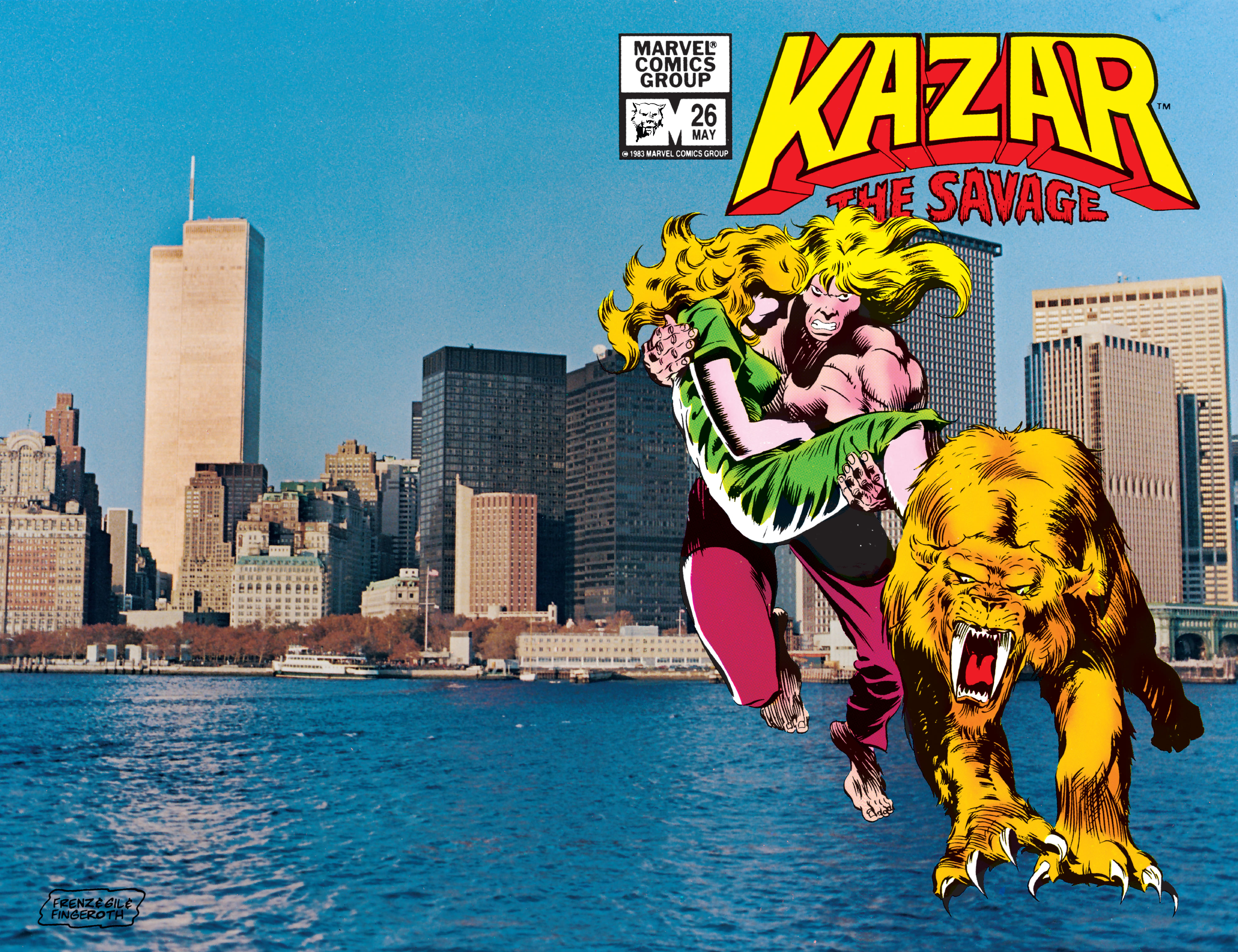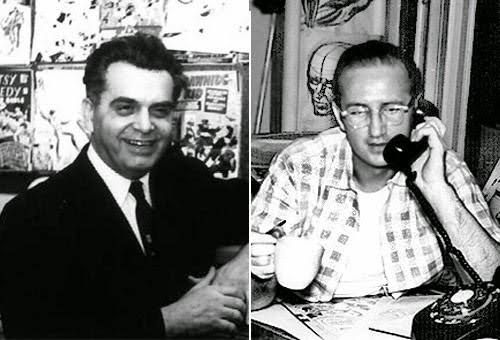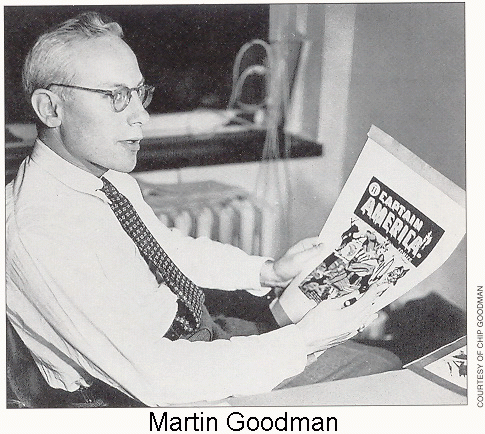MARVEL COMICS IN THE SILVER AGE
In the career-girl fashion of that era, Steinberg spent some months living at a YWCA and job-hunting through employment agencies. "After a couple of interviews, I was sent to this publishing company called Magazine Management. There I met a fellow by the name of Stan Lee, who was looking for what they called then a 'gal Friday'.... Stan had a one-man office on a huge floor of other offices, which housed the many parts of the magazine division.... Magazine Management published Marvel Comics as well as a lot of men's magazines, movie magazines, crossword puzzle books, romance magazines, confession magazines, detective magazines.... Each department took turns, one day a week, covering the switchboard...when the regular operator took her lunch break".[2]
Marvel's only staffers at that time were Lee and Steinberg herself, with the rest of the work handled freelance. De facto production manager Sol Brodsky "would come in and set up an extra little drawing board where he would do the paste-ups and mechanicals for the ads". She recalled that the "first real Bullpen" — the roomful of artists at drawing boards making corrections, preparing art for printing, and, as envisioned later within Marvel's letter pages and "Bullpen Bulletins", a mythologized clubhouse in which the likes of Lee, Jack Kirby, Steve Ditko, Don Heck and others would be found kibitzing — was created when Marvel moved downtown a few buildings from 655 Madison Avenue to 635 Madison Avenue (with Magazine Management at 625, the formal address found in the comics' indicia). "Stan finally had his own office. There was a big space with windows where I was, and Sol Brodsky, now on staff, had his own desk".[3] Among the first Bullpen staffers, Steinberg recalled, were Marie Severin and Morrie Kuramoto, followed by John Verpoorten and Herb Trimpe.
Artist Jim Mooney once recalled,
- She was wonderful! You’d go to DC and it was a business-like thing and I'd come out of there and I'd feel, 'Oh, God, I need a drink'. [laughter] I'd go to Marvel and I'd come in and Flo would say, 'Hello, Jim! Oh, I'll call Stan right away! Stan!!! Jim Mooney is here!!!' And I'd think, 'Oh my God, who am I? I'm a celebrity'. [laughter] She was great. It wasn't just me, believe me, it was everybody and anybody, but I still felt, well, it was really just me.[4]
The all-purpose Steinberg — given the sobriquet "Fabulous Flo", in the manner of many other Marvel Comics endearments — said that she
- ...became so overwhelmed with the fan mail and the Merry Marvel Marching Society fan club that Stan started. There was just so much work! I need extra help and had gotten this wonderful letter from a college girl in Virginia by the name of Linda Fite. She came up and was hired to help me out, though she eventually went on to do writing and production work.[3]
Steinberg became exposed to the underground comix scene after meeting and becoming friends with Trina Robbins, who had come to the Marvel offices to interview Lee for the Los Angeles Free Press alternative newspaper. Through her, Steinberg became acquainted with contributors to the New York City alternative paper the East Village Other, and met such underground cartoonists as Kim Deitch, Art Spiegelman, and Spain Rodriguez.
Journalist Robin Green, who succeeded Steinberg at Marvel in 1968, wrote in Rolling Stone:
- It was three years ago that I went to work at Marvel Comics. I replaced Flo, whose place I really couldn't take. Fabulous Flo Steinberg, as she was known to her public, was as much an institution in Marvel's Second Golden Age as Editor Stan (The Man) Lee himself. She joined Marvel just after Stan had revolutionized the comic industry by giving his characters dimension, character, and personality, and just as Marvel was catching on big.[5]
LATER CAREER
Steinberg left Marvel in 1968. "I was just tired. The last years were so long because the fan mail was overwhelming. Bags of it would come in, and all the letters had to be acknowledged".[6] The position itself, even after five years, was not particularly well-paid, and Steinberg quit after not receiving a $5 raise.[7] Marie Severin, recalling the day of Steinberg's going-away party, observed in 2002: "I think the stupidest thing Marvel ever did was not give her a raise when she asked for it because she would have been such an asset to have around later because she's so honest and decisive. ... I was thinking, 'What the hell is the problem with these people? She's a personality. She knows what she's doing. She handles the fans right. She's loyal to the company. Why the hell won't they give her a decent raise? Dummies.'"[8]
Editor-publisher Steinberg's Big Apple Comix (Sept. 1975). Cover art by Wally Wood.
Steinberg went to work for the American Petroleum Industry, leaving when that trade group relocated to Washington, D.C..[citation needed] A "Marvel Bullpen Bulletins" page in Marvel comics cover-dated February 1969 and necessarily written two to three months earlier noted that she "has a great new job at Rockefeller Center".[9] She moved to San Francisco, California, in the early 1970s, and later to Oregon before returning to New York City to help run Captain Company, the mail-order division of the horror-comics magazine firm, Warren Publishing.[10]
She spoke at a 1974 New York Comic Art Convention panel on the role of women in comics, alongside Marie Severin, Jean Thomas (sometime-collaborator of then-husband Roy Thomas) and fan representative Irene Vartanoff.[11]
A fictionalized Steinberg was portrayed as part of an alternate-reality Fantastic Four alongside Stan Lee, Jack Kirby, and Sol Brodsky in Marvel Comics' What If #11 (Oct. 1978). Art by Kirby and unspecified inker
[12]
In 1975, Steinberg published Big Apple Comix, a seminal link between underground comix and modern-day independent comics, with contributors including such mainstream talents as Neal Adams, Archie Goodwin, Denny O'Neil, Al Williamson, and Wally Wood.[13][14] Critic Ken Jones, in a 1986 retrospective review, suggested that Big Apple Comix and [Mark Evanier's] High Adventure may have been "the first true alternative comics".[15]
In the 1990s, Steinberg returned to work for Marvel as a proofreader, succeeding Jack Abel.



















![[Linked Image from unleashthefanboy.com]](http://www.unleashthefanboy.com/wp-content/uploads/2014/08/BatmanSamHammLSWarnerBros.jpg)